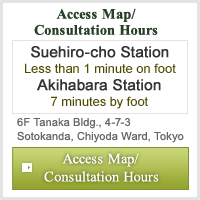トップへ » Juvenile periodontitis and dentures
Juvenile periodontitis and dentures
Q. I am still in my 30s and I have been diagnosed with juvenile periodontitis. I have had symptoms of periodontitis since I was in my teens. At the time, I visited the dental clinic and received instructions on how to use a toothbrush. I can wiggle my teeth by simply pressing my tongue against them. Recently I have been experiencing inflammation and pain, and a few of my teeth already seem as though they are about to fall out. I have a bridge on my molars but the whole thing is loose. If I lose my bridge will I have to get dentures?
A. Juvenile periodontitis (aggressive periodontitis) is a form of periodontitis that occurs in young people in their teens and 20s. It is said that the early appearance of this disease may be genetic or may be due to an abnormality in the immune system. One characteristic of this disease is that a bacteria called Actinobacillus actinomycetemcomiotans is usually present in large numbers.
In your case, it will be necessary to deal with your loose bridge and receive treatment for gingivitis at the same time. It is necessary to consider how you will handle the situation when your loose teeth with deep pockets surrounding them fall out. Frankly speaking, you will need to get false teeth or have dentures made. After that you should receive treatment for your gingivitis. Gingivitis is a disease in which the bone around a tooth becomes loose and eventually the tooth falls out. It is said to usually start when people are in their 20s. By having a dentist examine the inside of your mouth for the existence of bacteria that causes gingivitis, you will be able to get a better diagnosis and receive treatment.
There are 6 types of bacteria that cause gingivitis.
1. Porphylomonas gingivalis
2. Tannerella forsythensis
3. Treponemadenticola
4. Prevotera intermedia
5. Actinobacillus actinomycetemcomiotans
6. Fusobacterium nucleatum
[3DS, a new technique to get rid of gingivitis-causing bacteria in the mouth]
After removing plaque using PMTC (professional mechanical tooth cleansing), a procedure performed by a dental hygienist using specialized technology and equipment, a mouthpiece tray fitted to the patient's tooth alignment is placed in the mouth and medicine is applied to the surface of the teeth and left to sit for a certain period of time. This process is not negatively affected by saliva and antibacterial and fluoride medicine can be safely administered to the teeth.
3DS Method
1. Examine the saliva to determine whether or not bacteria elimination is necessary.
2. Provide ample explanation of the bacteria elimination process to the patient.
3. Take a mold of the patient's teeth for the construction of a mouthpiece tray.
4. Carry out PMTC to remove plaque from the surface of the patient's teeth.
5. Add medicine to the mouthpiece tray and let it sit for 5 minutes to eliminate bacteria.
6. Repeat the bacteria elimination process one week later.
7. Add fluoride gel to the mouthpiece tray at home and hold it in your mouth for 5 minutes twice a day at home (once in the morning and once after brushing your teeth at night before going to bed) in order to strengthen the teeth.
At our clinic we provide an examination report to the patient upon conducting a BML (Inc.) saliva test. The 3DS effect only lasts 4 - 6 weeks so we recommend that you have bacteria eliminated periodically.
When your gingivitis symptoms stabilize you must then secure your teeth to prevent them from wiggling. There is a simple procedures in which you attach loose teeth to the surrounding teeth with a dental adhesive, but if you have already lost many teeth, we recommend the telescope system as a treatment method (dentures developed in Germany).
トップへ » Juvenile periodontitis and dentures









